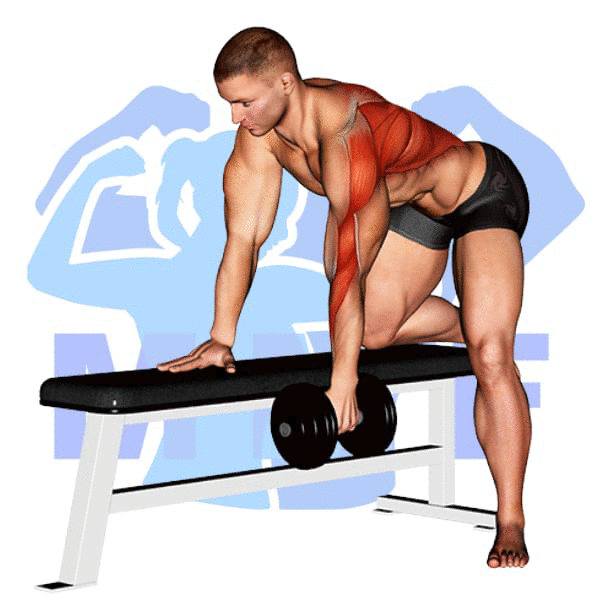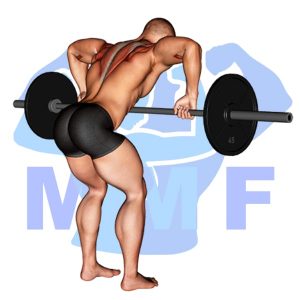Have you ever struggled with targeting your rear deltoids during your workout routine? It’s a common issue that many fitness enthusiasts face, and the solution may be simpler than you think. Often, the issue lies in not using the proper exercises to target those muscles. That’s where the dumbbell one arm rear deltoid row comes in. This exercise is a perfect solution to this problem, and in this post, we’ll dive into the details of how to perform it correctly and effectively to help you achieve your fitness goals.
Dumbbell One Arm Rear Deltoid Row Summary
- Primary Muscles: Deltoid – Posterior
- Secondary Muscles: Brachialis, Brachioradialis, Infraspinatus, Latissimus Dorsi, Rhomboids, Teres Minor, Trapezius – Lower, and Trapezius – Middle
- Equipment: Dumbbell and Bench
- Mechanics Type: Compound
- Force: Pull
- Utility: Basic

Dumbbell One Arm Rear Deltoid Row Instructions
- Start by selecting a dumbbell and placing one knee and the same side hand on a flat bench.
- Make a good base with your foot on the floor and pick up the dumbbell with your hand.
- Next, while keeping your back flat, pull the dumbbell up like you are starting a lawnmower, and keep you elbow close to your body.
- Then, squeeze your back at the top and slowly lower the dumbbell back down, but don’t let it touch the ground.
- Repeat these rows on onside then conduct the same number of reps on the other side to complete a full set.
Video Tutorial
Dumbbell One Arm Rear Deltoid Row Muscles
Target (Agonist)
Synergists
- Brachialis
- Brachioradialis
- Infraspinatus
- Latissimus Dorsi
- Rhomboids
- Teres Minor
- Trapezius – Lower
- Trapezius – Middle
- Wrist Flexors
Dynamic Stabilizers
Stabilizers
Antagonist Stabilizers

Benefits of Dumbbell One Arm Rear Deltoid Row
The Dumbbell One Arm Rear Deltoid Row is an effective exercise for targeting the posterior deltoid muscle. It is a great way to build strength and increase muscle size in the back of the shoulder. This exercise allows for a greater range of motion than other shoulder exercises, and can help to improve posture and shoulder stability. Additionally, it can help to reduce shoulder pain by strengthening the rotator cuff muscles and surrounding tissues. Performing this exercise regularly can help to improve overall shoulder function, as well as the look of the upper body.
Tips for Performing Dumbbell One Arm Rear Deltoid Row
When you need to experience the ideal muscle development, you will want to use these basic tips. Similarly, whenever you wish to minimize your chance of injuries, you should stick to these tips.
- cut down soreness by undertaking a only a few minutes of aerobic exercise directed at your primary muscle groups to finish your routine. This cardio exercise is flushing out much of the lactic acid. Therefore you shall be reducing your recovery.
- Improve Your Technique by Make Use Of A Mirror. You may well believe a little vain looking in a mirror while you are working out, but you are not checking yourself out, you are making sure your technique is strong.
- execute your major compound movements at the beginning of your work out, and then conduct isolation exercises to target particular muscle groups towards the end. You really want the pinnacle functionality of your individual muscle groups any time you do coumpound movements like, bench, squats and deadlifts. Then you need to work the areas that you determined were weak during those exercises, or zones that didn’t get fatigued based on the type of compound exercise you executed.
- Try Drop Sets. You can maximize your strength gains through drop sets. Drop sets are when you do a set to until you can do another rep and then you use smaller dumbbells and continue. You could reduce the weight many times.
Benefits and Tips Video
Frequent Mistakes To Avoid
You should stop these typical issues to ensure quality technique and continue to develop gains. Additionally, when you steer clear of these issues you will decrease the chance of receiving an injury.
- You Can’t Skip Out On Recovery Days. Overtraining can in fact help make you weakened in lieu bigger.
- Don’t use To Little or Too Much Resistance. Not enough, and you will not be adequately fatiguing your target muscles, too much, and you’ll most likely need to cheat. Make sure you concentrate on your technique.
- You’ll Do Better To Not Pass-Up Your Cooldown. You would have longer recovery time and more soreness if you ignore your cooldown.
Find More Dumbbell Exercises Here
Variations and Complementary Exercises
If you are looking for exercises to supplement or replace Dumbbell One Arm Rear Deltoid Row, there are several variations, complementary, and alternative exercises that you can do. All of these exercises work similar muscles as the Dumbbell One Arm Rear Deltoid Row and will help you build strength and stability in the same areas. Below is a list of such exercises.
Dumbbell Palm Rotational Bent Over Row

The Dumbbell Palm Rotational Bent Over Row is a great complementary or alternative exercise for the Dumbbell One Arm Rear Deltoid Row. This exercise focuses on the shoulders, biceps, and lats, and is done by holding a dumbbell in one hand with a neutral grip, bent over at the waist, and then rotating the wrist while rowing the dumbbell up towards your chest. This exercise helps to build strength in the rear deltoids and other muscles in the upper back, and can be used as a substitute for the Dumbbell One Arm Rear Deltoid Row.
EZ Bar Reverse Grip Bent Over Row

The EZ Bar Reverse Grip Bent Over Row is a great alternative or complementary exercise to the Dumbbell One Arm Rear Deltoid Row. It targets the same muscles as the Dumbbell One Arm Rear Deltoid Row, but adds an extra challenge by using an EZ bar. This exercise is performed by gripping the EZ bar with your palms facing down and bending your knees slightly. You then bend your torso forward until it’s almost parallel to the floor and pull the EZ bar up towards your chest while keeping your back straight. This exercise strengthens your back, shoulders, and arms, making it a great addition to any workout routine.
Inverted Rows

Inverted Rows are a great complementary or alternative exercise to the Dumbbell One Arm Rear Deltoid Row. This exercise is performed by gripping a bar with an overhand grip and lifting your body up until your chest touches the bar. This exercise helps to strengthen the back muscles, primarily the rhomboids and latissimus dorsi, while also engaging the core and biceps. Additionally, Inverted Rows are excellent for increasing upper body stability and body control. When performed regularly, Inverted Rows can help improve posture and reduce back pain.
Check Out These Top Dumbbell Exercises
Lever One Arm Lateral High Row (Machine)

The Lever One Arm Lateral High Row (Machine) is a great alternative or complementary exercise to the Dumbbell One Arm Rear Deltoid Row. This machine provides a more stable base for the exercise, allowing a greater range of motion and more consistent form. The exercise works the same muscles as the Dumbbell One Arm Rear Deltoid Row, but with a different angle of pull, which can help to target different areas and ensure a balanced workout. It also allows for a greater range of motion and more controlled movement, which can help to reduce the risk of injury.
Barbell Rear Delt Row

The Barbell Rear Delt Row is an effective exercise for targeting the back of the shoulder, or rear deltoids. It is performed by holding a barbell with a pronated grip and keeping the arms straight while rowing the barbell towards the stomach. The exercise is similar to the Dumbbell One Arm Rear Deltoid Row but with a few differences; it is a more compound movement, as it works both arms at the same time, and it also puts more emphasis on the lower traps and upper back muscles. The Barbell Rear Delt Row is an excellent complementary or alternative exercise for the Dumbbell One Arm Rear Deltoid Row as it helps to target the same muscle group, but with different loading and range of motion.
Cable Crossover Reverse Flys

Cable Crossover Reverse Flys can be a great complement or alternative to the Dumbbell One Arm Rear Deltoid Row. This exercise works the same muscle group, but in a different way. It involves pulling a cable down and across your body as you move your arms out to the sides and back in. This exercise can help to develop more muscular balance and control, while also targeting the rear deltoid muscles. Furthermore, it is an effective exercise for increasing shoulder stability and strength.
Find More Back Exercises Here
Opposing Complementary Exercises
In order to maximize the benefits of this exercise, it is important to work the opposing muscle groups as well. The following exercises are designed to do just that, providing a well-rounded workout that will help strengthen and tone your back muscles.
Dumbbell Bench Press

The Dumbbell Bench Press is a great complement to the Dumbbell One Arm Rear Deltoid Row, as it works the opposing muscle group. This exercise involves lying on your back and pressing dumbbells up above your chest, working the chest, triceps, and shoulders. This is an effective exercise for building strength and size in the upper body. The opposing muscle group worked in the Dumbbell One Arm Rear Deltoid Row is the back, specifically the rear deltoids. Combining these two exercises will ensure a balanced upper body workout, as both muscle groups are being worked in an opposing manner.
Cable Chest Press

The Cable Chest Press is a great complementary exercise to the Dumbbell One Arm Rear Deltoid Row. It works the opposing muscle group of the deltoid, targeting the chest muscles. By performing this exercise, you’ll help to ensure that your upper body is balanced and strong. This exercise will also engage the triceps and core muscles to help stabilize your body during the movement. With a proper form and full range of motion, you can help to build chest strength and size with the Cable Chest Press.
Decline Dumbbell Bench Press

The Decline Dumbbell Bench Press is an excellent exercise to pair with the Dumbbell One Arm Rear Deltoid Row. This exercise specifically targets the front deltoid muscles, which are the opposing muscle group to the rear deltoids worked in the row. It also works the chest and triceps muscles as well. Doing this combination of exercises helps to create balanced development in the shoulder area and ensures that all muscles are being targeted for optimal strength gains.
Transform Your Rear Delts with the Dumbbell Row
Transform your rear delts with the dumbbell row, an exercise that targets the muscles in the back of the shoulder. It’s a simple move that requires a set of dumbbells and a flat bench. By performing the dumbbell row correctly, you’ll see an improvement in your overall posture and upper body strength. It’s important to keep your back straight and engaged during the exercise, and to focus on squeezing your shoulder blades together as you pull the weight towards your chest. Incorporating dumbbell rows into your workout routine can help develop a more defined and sculpted look in your rear delts.
References: Wikipedia | ExRx.net | PubMed.gov | Comprehensive List of Back Dumbbell Exercises




